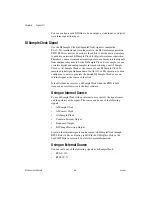
Chapter 5
Analog Output
5-2
ni.com
•
AO Sample Clock
—The AO Sample Clock signal reads a sample
from the DAC FIFO and generates the AO voltage.
•
AO Offset and AO Reference Selection
—AO offset and AO
reference selection signals allow you to change the range of the analog
outputs.
AO Offset and AO Reference Selection
AO offset and AO reference selection allow you to set the AO range. The
AO range describes the set of voltages the device can generate. The digital
codes of the DAC are spread evenly across the AO range. So, if the range
is smaller, the AO has better resolution; that is, the voltage output
difference between two consecutive codes is smaller. Therefore, the AO is
more accurate.
The AO range of a device is all of the voltages between:
(AO Offset – AO Reference) and (AO AO Reference)
The possible settings for AO reference depend on the device model. For
models not described below, refer to the specifications for your device.
(NI 622
x
Devices)
On NI 622
x
devices, the AO offset is always 0 V
(AO GND). The AO reference is always 10 V. So, for NI 622
x
devices,
the AO Range = ±10 V.
(NI 625
x
Devices)
On NI 625
x
devices, the AO offset is always 0 V
(AO GND). The AO reference of each analog output (AO <0..3>) can be
individually set to one of the following:
•
±10 V
•
±5 V
•
±APFI <0..1>
You can connect an external signal to APFI <0..1> to provide the AO
reference. The AO reference can be a positive or negative voltage. If AO
reference is a negative voltage, the polarity of the AO output is inverted.
The valid ranges of APFI <0..1> are listed in the device specifications.
You can use one of the AO <0..3> signals to be the AO reference for a
different AO signal. However, you must externally connect this channel to
APFI 0 or APFI 1.
















































